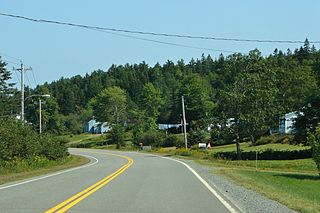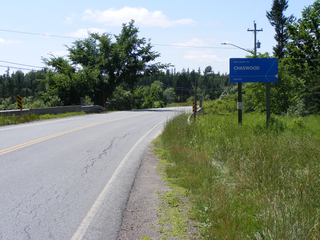Economy is an unincorporated rural community situated along the north shore of the Minas Basin/Cobequid Bay, at approximately 45°23'N, 63°54'W, in Colchester County, Nova Scotia. In the late 19th century, it was known for its shipbuilding industry.

Dean is a small farming and forestry community in the North Branch Musquodoboit in the Musquodoboit Valley along the Halifax Regional Municipality/Colchester County county line, in the Canadian province of Nova Scotia, along Route 336. Other communities in the North Branch include Elmsvale, Greenwood, Upper Musquodoboit, and Moose River Gold Mines, among others.

The Salmon River is a Canadian river in central Nova Scotia's Colchester County.

Onslow is a rural, unincorporated Canadian community in central Colchester County, Nova Scotia. The community is located along the north bank of the Salmon River, opposite the town of Truro and is largely a farming area. The area was first settled by Acadians and resettled after their expulsion as Onslow Township in 1761 by Irish emigrants under Colonel McNutt. The township is believed to have been named after Arthur Onslow.

Chaswood is a rural community in the Musquodoboit Valley northwest of Middle Musquodoboit, Nova Scotia in Nova Scotia, Canada. Chaswood is named in honour of Charles Carroll Wood.
Maitland, East Hants, Nova Scotia is a village in East Hants, Nova Scotia. It is home to the historic Lawrence House Museum, which is part of the Nova Scotia Museum. The William D. Lawrence ship was built here. The community was part of the Douglas Township until it was named Maitland after Lieutenant Governor of Nova Scotia Peregrine Maitland (1828–34) when building the Shubenacadie Canal was first attempted (1826–1831). The Canal was supposed to start at Maitland, Nova Scotia and run through the province to Maitland Street, Dartmouth, the canal being "bookended" by two "Maitland" landmarks.
Oak Lake (Nova Scotia) could mean the following lakes:
Upper Rawdon is a community in the Canadian province of Nova Scotia, located in the Municipal District of East Hants, which is in Hants County, Nova Scotia. This community was originally part of the Rawdon Township.
Glenholme is a community in the Canadian province of Nova Scotia, located in Colchester County.
Old Barns is a community in the Canadian province of Nova Scotia, located in Colchester County.

Port Howe is a community in the Canadian province of Nova Scotia, located in Cumberland County. The community is named after William Howe, 5th Viscount Howe.
Victoria is a community in the Canadian province of Nova Scotia, located in Cumberland County.
Thomson Station is a small community in the Canadian province of Nova Scotia, located in Cumberland County.
The Cobequid Pass is the name given to a 45 km (28 mi) tolled section of Nova Scotia Highway 104 between Thomson Station, Cumberland County and Masstown, Colchester County in the Canadian province of Nova Scotia. The section is a public–private partnership; the highway is owned by the Highway 104 Western Alignment Corporation, a Crown corporation of the Government of Nova Scotia, with a toll plaza operated under contract by Atlantic Highway Management Corporation Limited, a subsidiary of Aecon Concessions. The toll plaza is located near the halfway point in Londonderry. It opened in 1997.
Folly Mountain is a mountain and a community in the Canadian province of Nova Scotia, located in Colchester County on Trunk 4 in the Cobequid Hills.
Middle Stewiacke is a small community in the Canadian province of Nova Scotia, located in Colchester County in the Stewiacke Valley.
There are various Black Lakes in Nova Scotia, Canada. They vary widely in size, depth and usability. Many counties, such as Cumberland, Halifax, Inverness, and Pictou Counties have more than one Black Lake so named, while other counties mentioned in this article have only one named Black Lake.
The River Philip is a river contained entirely within Cumberland County, Nova Scotia, Canada.

The Stewiacke River is a river in the Canadian province of Nova Scotia that starts at Round Lake in Pictou County and flows into the Shubenacadie River in Colchester County running through the Stewiacke Valley.

A township in Nova Scotia, Canada, was an early form of land division and local administration during British colonial settlement in the 18th century. They were created as a means of populating the colony with people loyal to British rule. They were typically rural or wilderness areas of around 100,000 acres (400 km2) that would eventually include several villages or towns. Some townships, but not all, returned a member to the General Assembly of Nova Scotia; others were represented by the members from the county. Townships became obsolete by 1879 by which time towns and counties had become incorporated.







